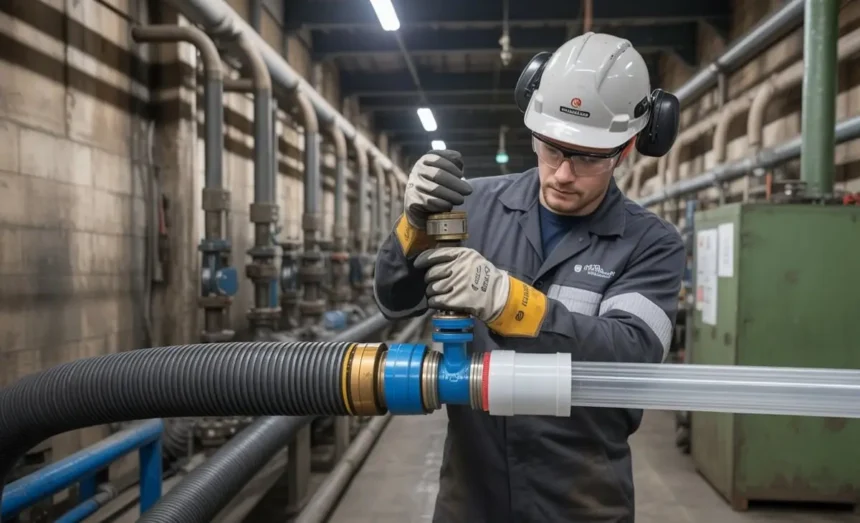Heavy-duty industrial operations require equipment that can withstand intense conditions. From high pressures and extreme temperatures to corrosive chemicals and constant abrasion, the demands are significant. When it comes to fluid transfer systems, selecting the right tubing is not just a matter of operational efficiency; it’s a critical component of safety and reliability. While rigid pipes have their place, flexible tubing offers versatility and resilience that are essential in many dynamic industrial environments.
Choosing the appropriate flexible tubing involves understanding the specific needs of your application and the properties of different materials. The right choice ensures a long service life, minimizes the risk of failure, and maintains the integrity of the system. This guide will explore the key factors to consider when selecting flexible tubing for heavy-duty operations and highlight some of the most durable materials available on the market.
Key Considerations for Heavy-Duty Tubing
Before diving into specific materials, it’s important to evaluate the operational environment where the tubing will be used. Answering the following questions will help narrow down the best options for your needs.
What Is the Operating Pressure?
The pressure rating of tubing is one of its most critical specifications. Heavy-duty applications often involve high-pressure systems, and using tubing that isn’t rated for that pressure can lead to catastrophic failure. Always check the manufacturer’s specifications for maximum working pressure and ensure it aligns with your system’s requirements, including any potential pressure spikes.
What Temperatures Will It Endure?
Both the internal fluid temperature and the external ambient temperature can affect the performance of flexible tubing. Materials can become brittle in extreme cold or lose their structural integrity in high heat. Selecting a material with a wide operating temperature range is crucial for applications with significant temperature fluctuations.
What Chemicals Will Be Transferred?
Chemical compatibility is non-negotiable. The tubing material must be able to resist corrosion, degradation, and swelling when exposed to the specific fluids being transferred. It’s essential to consult chemical compatibility charts to verify that the chosen material is safe for use with the chemicals in your system.
Does the Application Involve Abrasion or Kinking?
In many industrial settings, tubing is subject to external abrasion from contact with machinery, rough surfaces, or other hoses. It may also need to be routed around tight corners, creating the risk of kinking, which can restrict flow and damage the tube. Materials with high abrasion resistance and a good bend radius are necessary for these demanding conditions.
Top Materials for Flexible Heavy-Duty Tubing
With these factors in mind, let’s look at some of the most common and reliable materials for heavy-duty flexible tubing.
Rubber Hoses
Rubber has long been a go-to material for heavy-duty applications, and for good reason. Specific rubber compounds like Nitrile (NBR), EPDM, and Neoprene offer excellent flexibility and durability.
- Nitrile (NBR): Known for its outstanding resistance to oils, fuels, and petroleum-based hydraulic fluids, Nitrile is a popular choice in the automotive and manufacturing industries.
- EPDM: This synthetic rubber boasts excellent resistance to heat, ozone, and weathering, making it ideal for outdoor applications. It is also compatible with many water-based chemicals and steam.
- Neoprene: Offering a good balance of properties, Neoprene resists oils, chemicals, and ozone. It’s also valued for its toughness and abrasion resistance.
Fluoropolymers (PTFE, FEP, PFA)
Fluoropolymers are high-performance plastics known for their exceptional chemical resistance and high-temperature capabilities.
- PTFE (Polytetrafluoroethylene): Commonly known by its brand name, Teflon, PTFE has an almost universal chemical resistance and can handle temperatures up to 500°F (260°C). Its low-friction surface also helps maintain flow rates.
- FEP and PFA: These are melt-processible versions of PTFE that offer similar properties but with better clarity and flexibility in some cases. They are often used in pharmaceutical and food-grade applications where purity is essential.
Thermoplastic Materials
Modern thermoplastics offer a compelling combination of flexibility, strength, and chemical resistance. A high-quality thermoplastic hose can often provide a lightweight yet durable alternative to traditional rubber.
- Polyurethane (PU): This material is a champion when it comes to abrasion and tear resistance. It remains flexible even at low temperatures and is resistant to oils and fuels, making it suitable for pneumatic lines and fuel transfer.
- PVC (Polyvinyl Chloride): Reinforced PVC tubing is a cost-effective option for a wide range of applications. It offers good chemical resistance and can be formulated for various levels of flexibility and pressure ratings.
- Nylon: Known for its high strength and pressure rating, Nylon is often used in hydraulic and pneumatic systems. It has good heat and chemical resistance, though it can be less flexible than other thermoplastics.
Making the Right Choice for Your Operation
Selecting the right flexible tubing is fundamental to the safety and efficiency of your heavy-duty operations. By carefully evaluating your application’s specific requirements—including pressure, temperature, and chemical exposure—you can identify a material that provides the durability and performance needed to get the job done. Whether you choose a robust rubber hose, a high-performance fluoropolymer, or a versatile thermoplastic, investing in the right tubing will pay dividends in reliability and peace of mind.







